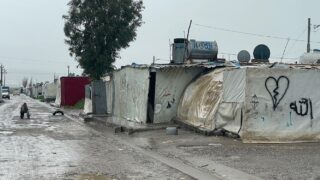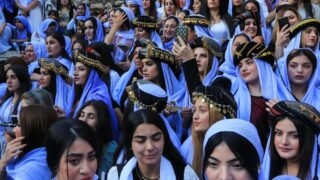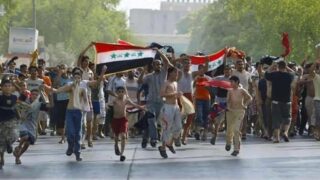
This publication has benefited from the support of the Rosa Luxemburg Foundation. This text may be reproduced in part or in full, provided the source is acknowledged.
In Iraqi Kurdistan, 700 thousand students out of 1.8 million have been denied education following the boycott that faculty members carried out. They were supposed to be among 13 million Iraqi students, begin the new academic year (2023-2024) with a comprehensive curriculum, and have academic faculty greet them by the school doors. The crisis that Iraq is currently undergoing is rooted in the political dispute between Baghdad (the capital of the central region) and Irbil (the capital of the Kurdistan region); it has cast a shadow over salaries in the Kurdistan region’s education system and, thus, over the education system as a whole.
On November 26, 2023, more than 1000 Kurdish professors headed to Baghdad to demand their salaries, which had been overdue for moths. They took their claims to Tahrir Square, marking the first Kurdish demonstration in that (extremely symbolic) square since the formation of Modern Iraq. However, the federal security forces blocked their passage through Kirkuk Governorate.
Besides its wage crisis, Iraq has borne the brunt of a collapsed education sector ever since the Iran-Iraq war, which was maintained with the siege (1990-2003), and all the way through the US occupation of Iraq, with ongoing repercussions.
The beginning of collapse
Prior to the Iran-Iraq war, public spending on the education sector made up 6% of the GDP and 20% of the Iraqi government’s budget. Dropout rates in Iraq used to be among the lowest in the Middle East. Iraq’s education system endured a heavy blow during that war; public spending on education dropped to half (3.3% of GDP) while school dropout rates soared to 20%.
The impact of loss can be clearly recognized in the education system when looking at the economic losses wrought by war, especially as Iraq relies on oil as an essential resource of national income. Iraq’s oil revenue losses were estimated at a staggering $260 billion, while more than a million people (from both Iraq and Iran) were killed. Even as the Iran-Iraq war came to an end, and despite its catastrophic aftermath, Iraq maintained its place among developed countries in the region and globally in terms of education. Research indexes and reports have even shown that, at times, Iraq surpassed other nations in this regard.
It was during the 13-year siege, however, that Iraq and its education sector were plunged into the Dark Ages. During those years, the infrastructure and overall moral foundation of the education system were destroyed. The public spending rate, which used to be $675 per student per year in 1978, dropped to less than 29 per student per year during the siege. But what does this gap mean? Had Iraq been spared the years of war followed by years of siege, its public spending on education would have reached $1271 per student in 1999.
A resounding collapse
Following the US invasion of Iraq in 2003, the collapse in the education sector was clear, both in statistical data and in observable reality. After the siege was lifted, Iraq maintained its ranking among developed countries, yet overall spending on education did not exceed 8%. Rapid population growth and a widened economic gap among social classes had an obvious impact on the education system. Since then, every ministry of education would fail to reclaim the past glories of Iraqi education, once hailed as a model for successful educational experiments during the mid-twentieth century.
According to the estimates based on budgetary allocations in Iraq between 2003 and 2021, public spending on education reached $82 billion, with an added $1 billion that the United States claimed to have spent on developing education in Iraq during that same period.
Prior to the Iran-Iraq war, public spending on the education sector made up 6% of the GDP and 20% of the Iraqi government’s budget. Dropout rates in Iraq used to be among the lowest in the Middle East. Iraq’s education system endured a heavy blow during that war; public spending on education dropped to half (3.3% of GDP) while school dropout rates soared to 20%.
While the figure may appear modest when compared with the size of annual State budgets allocated for that period, which Iraqis would refer to as “explosive budgets”, it remains a substantial number considering it was spent on a sector with thousands of students still going to schools made of mud. These schools received none of those services as the new regime, founded on the misappropriation of those very “explosive budgets”, seized control not only of the allocated funds for the education sector but also diverted resources from critical areas such as healthcare, security, and public services.Top of Form
____________
Assafir Al-Arabi's folders
The War on Iraq Two Decades On
____________
As with everything controlled by sectarian mafias in Iraq, the Ministry of Education is controlled by the head of the “Sunni” Al-Azm Alliance, MP Muthanna al-Samarrai, who is implicated in whale-sized corruption deals. In 2020, the Iraqi public prosecution presented the parliament with a warrant demanding that it strips al-Samarrai of his parliamentarian immunity over his involvement in the “health insurance” contract that the Ministry of Education had signed with the Lebanese-owned Ard al-Watan company. The public prosecution demanded that al-Samarrai be stripped of his immunity to bring him to trial, along with Minister of Education Suha al-Ali and other officials affiliated with and controlled by al-Samarrai. Notably, the Ministry of Education is considered al-Samarrai’s share as per the “points” principle, which political blocs assume in parliament when distributing positions whenever a new government is formed.
The value of that insurance contract reached 41 billion Iraqi dinars ($33 million). The deal was exposed after disputes erupted among Sunni parties over distributing the contract shares within the ministry, which has more than 700 thousand employees. 5500 Iraqi dinars are deducted from each employee on a monthly basis for healthcare services that they would never receive, as the implementation of the contract requires infrastructures that don’t exist in Iraq. The healthcare law began to be implemented in 2023 only, and it is still in its pilot phase.
Eventually, MP al-Samarrai retained his immunity and faced no prosecution. All that the case amounted to, following a number of political settlements, was that the Central Criminal Court of Iraq issued a preliminary ruling of three years imprisonment against the Ministry of Education account manager. The indictment was issued on the basis of the manager accepting a bribe to validate a health insurance contract between the Ministry of Education and Ard al-Watan company. Naturally, when one finds out that al-Samarrai is an ally to the Iranian political and military wings, it becomes easy to understand why the only one held accountable for a 33-million-dollar deal was the accounts manager, while Minister Suha al-Ali got away with it. Muthanna al-Samarrai is well known for a statement he has been repeating to promote his party for the local elections of December 2023: “We are all the sons of one father: Iraq”.
Mud schools
In December 2022, Prime Minister Mohammed Shiaa’ al-Sudani announced that Iraq needed 8000 schools to bridge infrastructure gaps in education. As he spoke, more than 1.4 million new students were about to enter schools, some of whom – with their new backpacks, saying goodbye to their parents to sit through the first class of their lives – would have to sit on the floor in a school made of mud, whose ceiling could collapse at any given moment. Sometimes, up to 45 students would be crammed into one classroom. In March 2023, the Rifaii administration of education ordered the evacuation of 16 mud schools that were prone to collapse at any moment, stating that there were 27 mud schools in the Rifaii region and Al-Nasir town. These two towns are close to Warka city, which was home to the Mesopotamian goddess of reading and writing, Nisaba, “the lady/goddess who brings in writing wherever she goes” and the woman who “holds a gold stylus, teaches on a tablet of clay, and paints the skies with stars”.
It was during the 13-year siege, however, that Iraq and its education sector were plunged into the Dark Ages. During those years, the infrastructure and overall moral foundation of the education system were destroyed. The public spending rate, which used to be $675 per student per year in 1978, dropped to less than 29 per student per year during the siege.
Lack of infrastructure is one of the biggest problems facing education in Iraq, alongside schools being understaffed. Although Iraq is considered to have one of the largest numbers of public employees (more than 4 million employees), the Ministry of Planning spokesperson revealed a “growing gap” in educational staff, which, according to ministry statistics, are estimated at 87,743 employees. He said that Iraq faces serious shortage in the education sector: 3,199 kindergarten teachers, 66,353 elementary school teachers, and 18,191 middle and high school teachers are needed. The head of the teacher’s union sees that such disparity between the number of students and teaching staff is “rooted in nepotism and favouritism”.
In parallel, school dropout rates have reached 35% in elementary schools and 45% in high schools. In a worrisome announcement, UNICEF stated that 3.2 million Iraqi school-age children have dropped out of school.
The post-2003 violence and disintegration that Iraq endured can explain such a collapse. The country hasn’t seen quiet times since it fell in the swamp of “US democracy”. Iraq also lived through a tough ISIL epoch, followed by a mass exodus, which peaked in 2015 “with more than 4.4 million Iraqis displaced and a quarter million of refugees”, which had largely ruined education across the country.
Despite Iraq's declaration in the 1980s that it had successfully eradicated illiteracy, a new law aimed at promoting literacy, Law No. 23, was enacted in 2011. The law stated: “In order to eradicate the illiteracy caused in recent times, and based on the constitution, which states that education is an essential factor for the advancement of society and a right that the country must guarantee its citizens, the state must implement its mission in fighting illiteracy and help illiterate people reach a level that enables the development of their life, culturally, socially, and economically, as well as exercise their civil rights and obligations”.
Following the legislation of the law, the Ministry of Education launched what it called a “strategy” to eradicate illiteracy in Iraq. It announced that it would “open literacy centres in the regions, towns, and city centres, and register the people concerned by this law directly in literacy courses. It would also provide training courses for literacy teachers, who would participate in the campaign in order to develop their abilities and skills in this domain. It would also print out thousands of posters that would encourage people to join those courses”.
In a conversation with Aljazeera, the then head of the communications department of the Ministry of Education said: “A supreme body will be formed to control and implement the articles of laws through committees, which would be composed of members from all Iraqi directorates of education in the different Iraqi regions and from those ministries concerned with the implementation of the law… Work is ongoing to form a literacy council in each region, in an attempt to eradicate illiteracy among those groups and guarantee that they don’t relapse”.
Twelve years after such governmental propaganda, namely in 2022, the UNICEF said that illiteracy in Iraq is now found among 47% of adults – that is, 11 million Iraqis. As Iraq denied those numbers, claiming that they were “exaggerated”, the Ministry of Planning published, a year later, its data on illiteracy. According to the ministry, 12.3% of Iraqis are illiterate across the country; illiteracy rates among females have reached around 28% and around 13% among males.
In December 2022, Prime Minister Mohammed Shiaa’ al-Sudani announced that Iraq needed 8000 schools to bridge infrastructure gaps in education. More than 1.4 million new students were about to enter schools, some of whom would have to sit on the floor in a school made of mud, whose ceiling could collapse at any given moment. In March 2023, the Rifaii administration of education ordered the evacuation of 16 mud schools that were prone to collapse.
Lack of infrastructure is one of the biggest problems facing education in Iraq, alongside schools being understaffed. Although Iraq is considered to have one of the largest numbers of public employees (more than 4 million employees), the Ministry of Planning spokesperson revealed a “growing gap” in educational staff, which, according to ministry statistics, are estimated at 87,743 employees.
Meanwhile, schoolbooks are also lacking. Iraqi families must add to their school spending the cost of buying books for their children, as the “business” of printing schoolbooks is factored into corruption deals too; ministerial printers have been taken over, and contracts are signed with printing houses abroad. Likewise, the curriculum is modified every few years, which generates massive revenues to the parties in control of education and the Ministry of Education. Notably, the sales deal with the Nahrein Printer, which is affiliated with the Ministry of Education, was approved, just as the “healthcare insurance” deal was approved without any protest. The only thing that did happen was a teacher’s union strike in 2019. Teachers demanded that the deal be investigated, but nobody heeded their pleas, and they had to return to work empty-handed after their strike.
Private education: an investment in ruin
The collapse of the public education sector, widespread corruption in the education system, and the transferring of the Ministry of Education from one party to another (as per the post-2003 Iraqi sectarian “Muhasasa”/quota system), as well as controlling (basic and higher) education through contracts and bids that generate billions of dollars to the party in charge, have all led to the rise of a private education sector. In its latest statistics, the Ministry of Education revealed that Iraq has more than 1400 private kindergartens (excluding the Kurdistan region) whereas the number of private elementary and high schools reached 2,884 schools, most of which are in Baghdad, which has 902 private schools, followed by Basra, with 566 private schools, whereas the number of public schools, whose completion is long overdue due to corruption deals, reached 1,031, including hundreds of schools that were built as part of the so-called Project No. 1.
Project No. 1 is one way in which the collapse of the Iraqi education system manifests. In 2011, the Iraqi authorities launched a project that aimed to demolish old schools and build 1,700 new ones instead. According to the project’s strategy report, which cost $200 million. Indeed, 1,700 schools were demolished; however, the widespread corruption in the Ministry of Education blocked the construction of new facilities in their stead. This resulted in a massive crisis, which later manifested in double and triple school shifts, where students and teaching staff resort to using the same school for elementary, middle, and high schools based on a “shift” system.
School dropout rates have risen to reach 35% in elementary schools and 45% in high schools. In a worrisome announcement, UNICEF stated that 3.2 million Iraqi school-age children have dropped out of school.
Iraqi families must add to their school spending the cost of buying books for their children, as the “business” of printing schoolbooks is factored into corruption deals too. Ministerial printers have been taken over, and contracts are signed with printing houses abroad, while the curriculum is changed every few years, which generates massive revenues to the parties in control of education and the Ministry of Education.
The growing private education sector drew in party and militia control and so precipitated a phenomenon of private universities and colleges, which became one of their funding sources. According to the Ministry of Higher Education and Scientific Research, there are 72 private universities and colleges, which receive students who pay their own tuition, as opposed to 35 public universities.
Profiting at the expense of quality is what pushed Iraq out of the Davos Index for Quality of Education in 2021, along with Yemen, Syria, Libya, Somalia, and Sudan. The growing private education market is what made the militia, Asa'ib Ahl al-Haq, choose the Ministry of Higher Education and Scientific Research among its shares in the incumbent government, appointing its spokesperson, Naeem al-Aboudi, as Minister of Higher Education.
According to Iraqi law, private universities give 3% of their annual revenues to the Ministry of Education. They also offer partnerships, contracts, and security firms. They attract supporters and form a popular base for parties and militias; they do so by providing aid to students who participate in political activities and vote for the party that owns and controls the university.
Project No. 1 is one way that the collapse in the Iraqi education system manifests. In 2011, the Iraqi authorities launched a project that aimed to demolish old schools and build 1,700 new schools instead – a project that cost $200 million. 1700 schools were demolished, but the widespread corruption in the Ministry of Education prevented the construction of new schools. It resulted in a massive crisis, which later manifested in double and triple school shifts.
Obtaining a graduate degree increases one’s privileges in Iraq. Corruption grows faster as the number of MA and PhD seekers rises. Every year, the Ministry of Higher Education records approximately 50 thousand MA and PhD degrees, most of which are given to people studying in private universities. The destinations where a scientific degree is easiest to obtain are Iran and Lebanon.
In 2021, the cultural attaché in Iraq’s Embassy in Lebanon was summoned for investigation, after the number of degrees given to Iraqi students reached 27 thousand degrees in 2020 in Lebanon. That same year, the Iraqi Ministry of Education suspended education in three Lebanese universities: The Modern University for Business and Science, the Islamic University of Lebanon, and Al-Jinan University. According to the ministry, these universities had “failed to comply with standards of scientific rigor”. As regards political/armed parties, the Ministry of Higher Education is a source of riches and influence. Obtaining postgraduate degrees is the dream of any politician who aspires to become a minister and be called “His Excellency Dr. so-and-so”.
Of those “excellencies” is Naeem al-Aboudi, the Minister of Higher Education in flesh and blood. The story behind his appointment explains much of the miserable conditions that the education system in Iraq has reached. Al-Aboudi explains how he received a phone call at midnight from Asa'ib Ahl al-Haq militia leader, Qais al-Khazali, who told him to “get dressed and come over immediately to become the new Minister of Higher Education”.
The Minister of Higher Education and Scientific Research was the spokesperson for the Asa'ib Ahl al-Haq militia. He holds a PhD in Arabic and an MA in Human Rights from the Islamic University of Lebanon, which is no longer recognized by the Ministry of Higher Education and Scientific Research in Iraq.
There are dozens of senior officials in critical positions in the Iraqi state who have received their postgraduate degrees from that university. They include, among others, Chief Justice Faiq Zidan and the Secretary-General of the Council of Ministers Hamid al-Ghazi.
The growing private education sector drew in party and militia control and so precipitated a phenomenon of private universities and colleges, which became one of their funding sources. According to the Ministry of Higher Education and Scientific Research, there are 72 private universities and colleges, which receive students who pay their own tuition, as opposed to 35 public universities.
The Minister of Higher Education and Scientific Research was the spokesperson for the Asa'ib Ahl al-Haq militia. He holds a PhD in Arabic and an MA in Human Rights from the Islamic University of Lebanon, which is no longer recognized by the Ministry of Higher Education and Scientific Research in Iraq.
As in other life sectors, the collapse of education impacts the overall governance structure at the state level. One such effect is manifested in the healthcare system. The head of the Iraqi Pharmacists Syndicate warns of a “devastating collapse of healthcare reality” as a result of the deteriorated level of medical education in Iraq. One of the recommendations that the Pharmacists’ Syndicate and Ministry of Planning proposed to the Council of Ministers is to discontinue the establishment of new medical schools, both public and private, as the inflated number of doctors and pharmacists has become “unbearable”.
According to the head of the syndicate, by 2030, Iraq will have around 98 thousand extra pharmacists, which means they will join the masses of the unemployed. Such failure, caused by the deteriorated education in Iraq and the subsequent chaos, denies the country revenues and labor market wages. The losses Iraq suffers due to the “complacent” education system range between 17.65 and 29.95 percentage points of the GDP. Such losses are mainly the cash flow that Iraq would have gained had its youth received the same level of education that youth in high average income countries receive.
The content of this publication is the sole responsibility of Assafir Al-Arabi and Rosa Luxemburg Foundation cannot accept any liability for it.
Translated from Arabic by Yasmine Haj
Published in Assafir Al-Arabi on 06/12/2023







